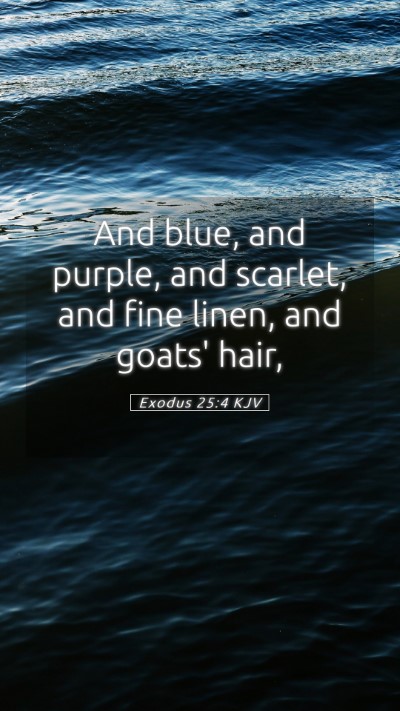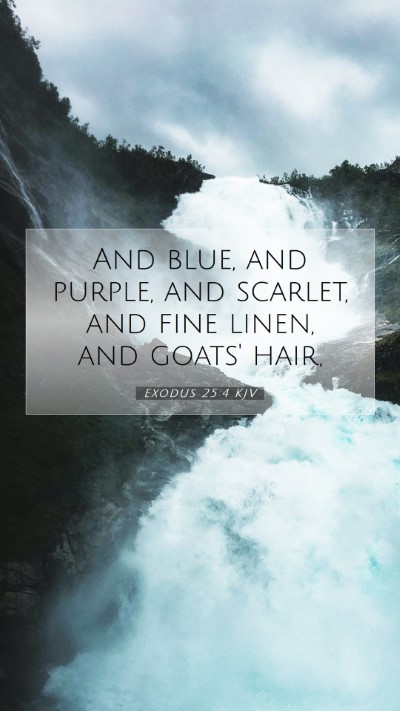Understanding Exodus 25:4
The verse Exodus 25:4 states, "And blue, and purple, and scarlet, and fine linen, and goats' hair,". This verse is a part of the instructions given to Moses regarding the offerings required for the construction of the Tabernacle, the dwelling place of God among His people. To understand the significance of this verse, we can delve into Bible verse meanings, Bible verse interpretations, and Bible study insights from renowned commentaries.
Context of Exodus 25
Exodus 25 marks a significant moment in the narrative of the Israelites. Moses is commanded by God to collect offerings from the people to create the Tabernacle, which is a foreshadowing of God's presence among humanity. This chapter outlines the materials needed, highlighting the meticulous nature of God in His worship and the beauty He desires in His dwelling place.
Significance of the Materials
Each material mentioned in this verse carries deep symbolic meanings:
- Blue: Represents Heaven and divine revelation.
- Purple: Symbolizes royalty and nobility, often associated with kingship.
- Scarlet: Indicates sacrificial blood, representing atonement and the cost of sin.
- Fine linen: Represents purity, righteousness, and the clean aspect of worship.
- Goats' hair: Often signifies humility and sacrifice, indicating the offerings of the poorer members of society.
Commentary Insights
Here are several insights from public domain commentaries which expand on the meaning of this verse:
Matthew Henry’s Commentary
Henry emphasizes the divine order in which the Israelites were instructed to donate materials for the Tabernacle. He notes that God desires beauty and glory in His worship, which shows the proper reverence one should have when approaching God. He highlights how the choice of these colors points to Christ, suggesting a connection to the New Testament in terms of the salvation narrative.
Albert Barnes’ Notes
Barnes focuses on the suitedness of each material for the construction of the Tabernacle. He explains how the colors represent the majesty and holiness of God. Furthermore, Barnes reflects on the communal aspect of giving, pointing out that every Israelite had a role in building the place where God would meet with them.
Adam Clarke’s Commentary
Clarke provides a detailed exploration of the textures and types of materials listed. He explains that each item not only serves a physical purpose but also carries spiritual implications. Clarke encourages readers to see the Tabernacle as a prototype for understanding God’s ultimate plan for humanity through Christ.
Application in Daily Life
Understanding this verse allows believers to reflect on their approach to worship:
- Do we offer our best to God in service and worship?
- How do the materials symbolize our relationship with God and our communal responsibilities?
- Can we find areas where ordinary offerings can glorify God?
Cross References
For a deeper understanding, consider these related verses that provide context and richness to Exodus 25:4:
- Exodus 26:1 - The dismissal of the Tabernacle coverings and their significance.
- Numbers 4:5-6 - Instructions on moving the Tabernacle and its sacred items.
- Hebrews 9:2 - Reference to the earthly Tabernacle as a shadow of heavenly things.
Conclusion
Exodus 25:4 serves as a powerful reminder of God's desire for beauty and holiness in worship, represented by the specific materials highlighted in the text. By studying this verse through Biblical exegesis and engaging with quality Bible study resources, one can gain extensive insights into the essence of worship and the significance of the Tabernacle in the broader narrative of the Bible.


